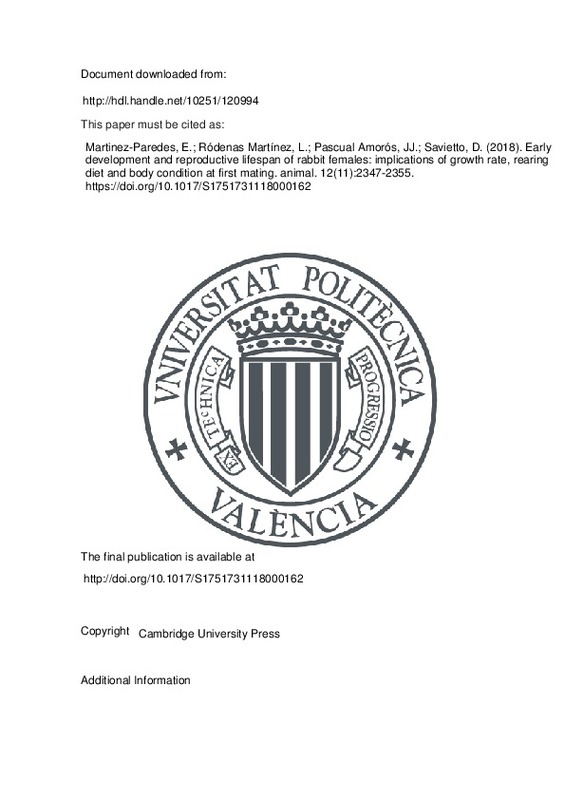JavaScript is disabled for your browser. Some features of this site may not work without it.
Buscar en RiuNet
Listar
Mi cuenta
Estadísticas
Ayuda RiuNet
Admin. UPV
Early development and reproductive lifespan of rabbit females: implications of growth rate, rearing diet and body condition at first mating
Mostrar el registro sencillo del ítem
Ficheros en el ítem
| dc.contributor.author | Martinez-Paredes, Eugenio
|
es_ES |
| dc.contributor.author | Ródenas Martínez, Luis
|
es_ES |
| dc.contributor.author | Pascual Amorós, Juan José
|
es_ES |
| dc.contributor.author | Savietto, Davi
|
es_ES |
| dc.date.accessioned | 2019-05-23T20:01:33Z | |
| dc.date.available | 2019-05-23T20:01:33Z | |
| dc.date.issued | 2018 | es_ES |
| dc.identifier.issn | 1751-7311 | es_ES |
| dc.identifier.uri | http://hdl.handle.net/10251/120994 | |
| dc.description.abstract | [EN] Factors influencing early development such as birth weight, nest competition, and the diet received during rearing have been proposed as elements conditioning the future reproductive performance of European rabbit (Oryctolagus cuniculus) females. To evaluate their effects, we followed the life of 1513 females from birth to time of death, culling or censoring (animals alive at a fixed date). Between 0 and 63 days of age 353 females died. From the remaining 1160 females, 864 were chosen based on their birth weight to be transferred from the selection to the production farm. At this farm, 431 females received the control diet (184g of CP, 381 g of NDF and 11.8 MJ of DE per kg DM), while the other 433 received the fibrous diet (134 g of CP, 436g of NDF and 10.0 MJ of DE per kg DM). Throughout the rearing period, we checked for the individual live weight and body condition (perirenal fat thickness) at first artificial insemination. Reproductive lifespan was defined as the number of days between the first parturition and the time of death, culling or censoring. Birth weight affected the survival of newborn females during lactation and the presence of a milk spot at birth (related to nest competition) increased the survivability of newborns weighing <45g (P <0.001). Rearing diet altered the growth curve of females and their body condition at first insemination. The diet also altered the relative risk of death during the rearing period, which was lower among females fed on the fibrous diet (-12.5%; P < 0.001). Therefore, a higher number of females fed with this diet reached their reproductive life, directly affecting the productivity measured per housed female. Fatter females at first insemination had smaller litter sizes and a higher risk of being culled than lean ones (P < 0.05). In general, the fibrous diet reduced the risk of leaving the herd at early rearing, and both birth weight and perirenal fat thickness affected female's reproductive lifespan. An excess of fat (positive change in one unit of perirenal fat) at their first insemination represented an increased the risk of death or elimination of 13%. | es_ES |
| dc.description.sponsorship | The authors acknowledge Cesar Villalba (Fabara, Spain), Luis Eroles (Valderrobres, Spain) for the technical support in managing the animals and for kindly providing a space to conduct our study. They also thank the Commission for Science and Technology (CICYT) of the Spanish Government (AGL2014-53405-C2-1-P) for the economic support to carry out this study. | es_ES |
| dc.language | Inglés | es_ES |
| dc.publisher | Cambridge University Press | es_ES |
| dc.relation.ispartof | animal | es_ES |
| dc.rights | Reserva de todos los derechos | es_ES |
| dc.subject | Oryctolagus cuniculus | es_ES |
| dc.subject | Birth weight | es_ES |
| dc.subject | Nutrition | es_ES |
| dc.subject | Reproduction | es_ES |
| dc.subject | Survival | es_ES |
| dc.subject.classification | NUTRICION Y BROMATOLOGIA | es_ES |
| dc.subject.classification | PRODUCCION ANIMAL | es_ES |
| dc.title | Early development and reproductive lifespan of rabbit females: implications of growth rate, rearing diet and body condition at first mating | es_ES |
| dc.type | Artículo | es_ES |
| dc.identifier.doi | 10.1017/S1751731118000162 | es_ES |
| dc.relation.projectID | info:eu-repo/grantAgreement/MINECO//AGL2014-53405-C2-1-P/ES/MEJORA GENETICA DEL CONEJO DE CARNE:RESPUESTA A LA SELECCION Y SU EFECTO SOBRE LA REPRODUCCION, ALIMENTACION Y SALUD UTILIZANDO UNA POBLACION CONTROL CRIOCONSERVADA/ | es_ES |
| dc.rights.accessRights | Abierto | es_ES |
| dc.contributor.affiliation | Universitat Politècnica de València. Departamento de Ciencia Animal - Departament de Ciència Animal | es_ES |
| dc.description.bibliographicCitation | Martinez-Paredes, E.; Ródenas Martínez, L.; Pascual Amorós, JJ.; Savietto, D. (2018). Early development and reproductive lifespan of rabbit females: implications of growth rate, rearing diet and body condition at first mating. animal. 12(11):2347-2355. https://doi.org/10.1017/S1751731118000162 | es_ES |
| dc.description.accrualMethod | S | es_ES |
| dc.relation.publisherversion | http://doi.org/10.1017/S1751731118000162 | es_ES |
| dc.description.upvformatpinicio | 2347 | es_ES |
| dc.description.upvformatpfin | 2355 | es_ES |
| dc.type.version | info:eu-repo/semantics/publishedVersion | es_ES |
| dc.description.volume | 12 | es_ES |
| dc.description.issue | 11 | es_ES |
| dc.identifier.pmid | 29458446 | |
| dc.relation.pasarela | S\355325 | es_ES |
| dc.contributor.funder | Ministerio de Economía y Competitividad | es_ES |







![[Cerrado]](/themes/UPV/images/candado.png)

